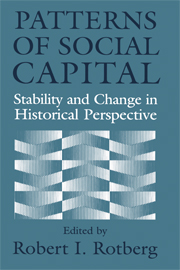Book contents
- Frontmatter
- Contents
- Introduction Social Capital and Political Culture in Africa, America, Australasia, and Europe
- Articles
- Civic Traditions in Premodern Italy
- The Sources of Civil Society in Italy
- Finding Social Capital: The French Revolution in Italy
- Social Capital in the Early Industrial Revolution
- The Diversity of Social Capital in English Communities, 1300–1640 (with a Glance at Modern Nigeria)
- Social and Cultural Capital in Colonial British America: A Case Study
- The Growth of Voluntary Associations in America, 1840–1940
- Civil Society as Democratic Practice: North American Cities during the Nineteenth Century
- Securing Political Returns to Social Capital: Women's Associations in the United States, 1880s–1920s
- Second-Generation Civic America: Education, Citizenship, and the Children of Immigrants
- Human Capital and Social Capital: The Rise of Secondary Schooling in America, 1910–1940
- From Local to National Political Cultures: Social Capital and Civic Organization in the Great Plains
Social Capital in the Early Industrial Revolution
Published online by Cambridge University Press: 12 April 2010
- Frontmatter
- Contents
- Introduction Social Capital and Political Culture in Africa, America, Australasia, and Europe
- Articles
- Civic Traditions in Premodern Italy
- The Sources of Civil Society in Italy
- Finding Social Capital: The French Revolution in Italy
- Social Capital in the Early Industrial Revolution
- The Diversity of Social Capital in English Communities, 1300–1640 (with a Glance at Modern Nigeria)
- Social and Cultural Capital in Colonial British America: A Case Study
- The Growth of Voluntary Associations in America, 1840–1940
- Civil Society as Democratic Practice: North American Cities during the Nineteenth Century
- Securing Political Returns to Social Capital: Women's Associations in the United States, 1880s–1920s
- Second-Generation Civic America: Education, Citizenship, and the Children of Immigrants
- Human Capital and Social Capital: The Rise of Secondary Schooling in America, 1910–1940
- From Local to National Political Cultures: Social Capital and Civic Organization in the Great Plains
Summary
“The first rule” of France's paperworkers was “to be the despotic masters of their bosses.” Journeymen across early modern Europe forged associations to control hours, output, and the identity of their shopmates. Short-lived or venerable, these combinations turned the world of production upside down. An anonymous mémoire from France raged that “the master [papermakers] are like slaves of the journeymen and workers.” In 1771, an alarmed observer recast this levelling in political terms: “The journeymen paperworkers form a sort of little republican state in the midst of the monarchy.” This muscular republic had deposed the hierarchy formally inscribed in the craft. The state was concerned, too. Writing in 1772, a provincial official in the Auvergne worried about “a republic of inferior workers, accustomed to laying down the law to the masters.” He knew that the paperworkers' association defined their social responsibilities and shaped their patterns of mutual assistance. It was the journeymen's civic body, and the persistent measure of more than one civic tradition in the trade. Master papermakers and journeymen did not perceive themselves as members of a craft community with a single set of interests.
For Putnam, medieval craft guilds were distant nurseries of effective political reform in modern Italy. More precisely, in his influential study, Making Democracy Work, Putnam contends that the craft communities were incubators of social capital. As he understands it, social capital amounts to the “norms of reciprocity and networks of civic engagement” at the base of responsive, democratic government. These connections, he argues, were egalitarian in texture and operation.
- Type
- Chapter
- Information
- Patterns of Social CapitalStability and Change in Historical Perspective, pp. 97 - 120Publisher: Cambridge University PressPrint publication year: 2000
- 1
- Cited by



